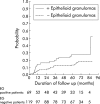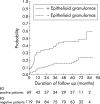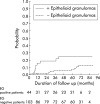Frequency and significance of granulomas in a cohort of incident cases of Crohn's disease
- PMID: 15647184
- PMCID: PMC1774855
- DOI: 10.1136/gut.2004.041715
Frequency and significance of granulomas in a cohort of incident cases of Crohn's disease
Abstract
Background and aims: Epithelioid granulomas is one of the best histological criterion for distinguishing Crohn's disease (CD) from other inflammatory bowel diseases. Few data are available on the time of occurrence of epithelioid granulomas, and the value of epithelioid granulomas in predicting outcome has been determined only in cohorts of prevalent CD cases. Our objective was to evaluate epithelioid granuloma occurrence in incident CD cases and to examine the associations between epithelioid granulomas and outcome.
Patients and methods: We reviewed the histological reports of endoscopic and surgical specimens in a cohort of 188 consecutive incident CD cases seen in 1994 and 1995, and recorded the occurrence of epithelioid granulomas, isolated giant cells, and microgranulomas. Kaplan-Meier curves were plotted for time from CD diagnosis to immunosuppressive treatment or surgery, and associations between epithelioid granulomas and outcome were evaluated in a multivariate analysis. Follow up was at least five years.
Results: Granulomas were found in 69 (37%) patients, including 46 (25%) at presentation. Median time from CD diagnosis to epithelioid granuloma detection was 0.16 (0-63) months overall, and 9.59 (0.1-63) months in 23 patients who became epithelioid granuloma positive during follow up. Isolated giant cells were found in 6% of patients and microgranulomas in 12%. Epithelioid granuloma detection increased with the number of endoscopic sampling procedures; sampling site had no influence. By multivariate analysis, epithelioid granulomas were associated with surgical resection but not immunosuppressive therapy.
Conclusions: Epithelioid granulomas may separate CD into two pathological subsets and may indicate aggressive disease.
Figures




Comment in
-
Granuloma formation in the different phenotypes of Crohn's disease.Gut. 2005 Feb;54(2):180-1. doi: 10.1136/gut.2004.048082. Gut. 2005. PMID: 15647175 Free PMC article. No abstract available.
References
-
- Lennard-Jones JE. Classification of inflammatory bowel disease. Scand J Gastroenterol 1989;24:2–6. - PubMed
-
- Lennard-Jones JE, Lockhart-Mummery HE, Morson BC. Clinical and pathological differentiation of Crohn’s disease and proctocolitis. Gastroenterology 1968;54:1162–9. - PubMed
-
- Bernades P , Hecketsweiler P, Benozio M, et al. Proposition d’un système de critères pour le diagnostic des entérocolites inflammatoires cryptogénétiques (maladie de Crohn et rectocolite hémorragique). Gastroenterol Clin Biol 1978;2:1047–54. - PubMed
Publication types
MeSH terms
Substances
LinkOut - more resources
Full Text Sources
Medical
